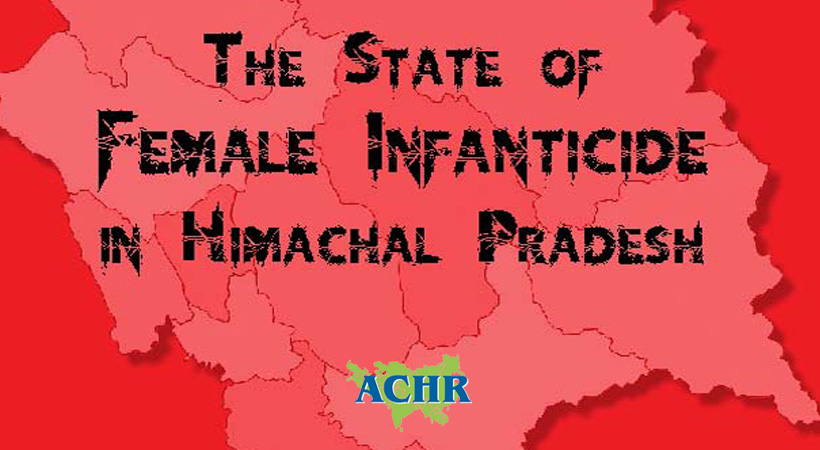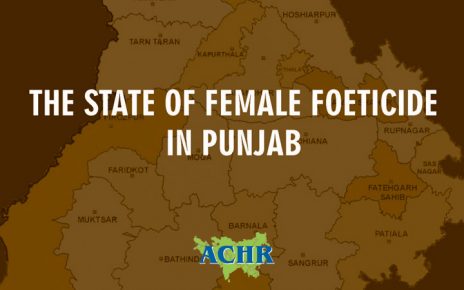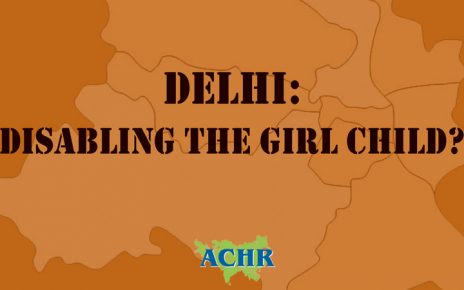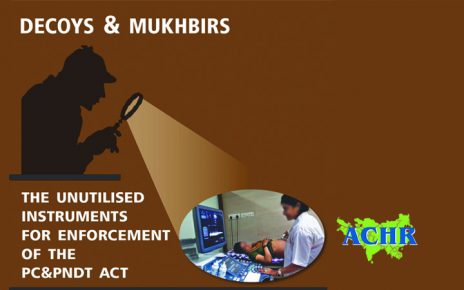Child Sex Ratio (CSR) has seriously declined from 982 female per 1000 boys (0-6 years) in 1971, the period before the use of the ultrasound machines, to 909 in 2011 in Himachal Pradesh. All the top five districts of the State with lowest CSR i.e. Una (870), Kangra (873), Hamirpur (881), Bilaspur (893) and Solan (899) are either bordering or near to Punjab which has the second lowest CSR (846) in India as per 2011 census. Solan (899) and Sirmaur (931) districts also border Haryana which infamously ranks No. 1 in skewed CSR in India. In at least 24 panchayats of Una district, which borders Punjab, the CSR reportedly fell to below 500. Worst, in two gram panchayats of Una, the sex ratio was 111 and 167 respectively! The Himachal Pradesh government suspected that illegal abortion clinics in Nangal and Hoshiarpur (in Punjab) were providing an easy service to women from Himachal Pradesh to terminate their female foetuses. There have been reports of mobile vans fitted with ultrasound equipment clandestinely visiting rural areas in Himachal Pradesh to conduct sex determination tests, and later female fetuses being aborted. The Himachal Pradesh government accused non-cooperation from Punjab government for protecting the girl child.
However, the efforts of the Himachal Pradesh government itself to retain the girl child are non-serious. In 2007, it launched Indira Gandhi Balika Suraksha Yojana (BSY) with the primary objective to improve the deteriorating sex ratio. In July 2010, the State government replaced the BSY with Beti Hai Anmol Yojana (BHAY) to address female infanticide/foeticide that provided a meager Rs 5,100 as post birth benefits to Below Poverty Line (BPL) parents having upto two girl children in the family in order to save the girl child. It has been estimated by the State governments that the beneficiary girl child will get Rs 23,585 after 18 years at the current interest rate of 9% on fixed deposit of Rs 5,000. The BHAY also provides for annual scholarship ranging from Rs. 300 to Rs. 1500 for the girl child. The post birth grant was increased to Rs 10,000 in June 2012. But the amount is too meager to be an incentive even for the BPL families. The BHAY excludes those above the poverty line, middle class and upper class who have been found to resort to abortion of the female foetuses. The urban CSR is far worse than that in rural areas.
The coverage of theBetiHai Anmol Yojana is extremely limited. The Comptroller & Auditor General (CAG) of India in its report on Social, General and Economic Sectors (Non-Public Sector Undertakings) for the year ending on 31 March 2014 noted that against 18,222 beneficiaries identified during 2011-14 under postbirth grant, only 13,332 beneficiaries were covered while 4,890 beneficiaries comprising 27% remained deprived of the intended benefits. Similarly, against 80,554 beneficiaries identified during 2011-14 under Scholarship scheme, only 63,881 beneficiaries were covered while 16,673 beneficiaries constituting 21% were deprived of scholarship. The CAG stated that the failure to cover all the identified beneficiaries due to lack of funds was not convincing as the funds were sanctioned.
However, the replies provided by the State of Himachal Pradesh under the Right to Information Act, 2005 to the Asian Centre for Human Rights (ACHR) show that the CAG report was generous to the State Government. Under the Beti Hai Anmol Yojana a total of 5,930 were given post birth assistance and about 8005 girls were given scholarships under the scheme in 12 districts i.e. Kullu Manali, Bilaspur, Mandi, Kangra, Shimla, Chamba, Una, Kinnaur, Solan, Kandaghat and Lahaul & Spiti from 2010 to 2015.
Even this coverage under the BHAY should be taken with a pinch of salt. The Utilization Certificates (UCs) provided by the Child Development Project Officers (CDPOs) of Himachal Pradesh to ACHR under the RTI Act expose a disturbing trend. In Kullu district, only a few utilization certificates are complete in all respects i.e. in proper format, with date, signature and stamp of the concerned officer while ten UCs issued by the CDPO, ICDS Kullu involving Rs. 24,30,000 utilised during 27.04.2011-20.04.2015 were found to be prepared only for purpose of sharing them under the RTI Act. In Mandi district, one UC issued by the CDPO, ICDS Chauntra in respect of Rs. 4,00,000 was found to be without date and official stamp while the CDPO, ICDS Dharampur has not provided any UC. In Kangra district, the CDPO of ICDS Baijnath did not provide any UC despite distribution of post-birth grants to 259 beneficiaries while the CDPO, ICDS Panchrukhi also did not provide any UC despite distribution of post-birth grants to 110 beneficiaries @ Rs. 5100 during 2010-2012 and to 77 beneficiaries @ Rs.10000 during 2012-2015. The CDPO, ICDS Lambagaon under Kangra district also did not provide any UC although despite disbursement of post-birth grant to 169 girls @ Rs. 5100 during 2010-2012 and to 49 girls @ Rs. 10000 during 2012-13. In Una district, the CDPO of Vangana ICDS did not provide any UC although despite disbursement of post-birth grant @ Rs. 10,000 to 127 beneficiaries; post-birth grant @ Rs.5,100 to 81 beneficiaries and scholarship @ Rs. 3001500 to 439 beneficiaries during 2010-11 to 2014-15. In Kinnaur district, the CDPO, ICDS Bhabanagar provided copies of five UCs in respect of only Rs. 3,70,000 against receipt of Rs. 9,95,000 during 2011-12 to 2014-15.
On the other hand, enforcement of the Preconception and Pre-Natal Diagnostic Techniques (Prohibition of Sex Selection) Act, 1994 (PCPNDT Act) remains extremely poor despite rampant violations. The Health Minister of India Mr J P Nadda informed in the Rajya Sabha (Upper House) on 3 March 2015 that a total of 206 convictions have been secured under the PCPNDT Act in India during 2009 to December 2014. Out of these, only one conviction (in 2013) was secured in Himachal Pradesh. As of June 2014, only one conviction was secured while no medical license was suspended or cancelled nor was any ultrasound machine seized or sealed. This means that the medical license of the convicted doctor was not suspended or cancelled. Further, only one conviction sits uneasily with the reports of the National Crime Records Bureau (NCRB) which reported that during 2004 to 2014, a total of 14 cases of foeticide in Himachal Pradesh, including 2 cases in 2004, 1 in 2005, 5 in 2006, 1 in 2007, 2 in 2008, 1 in 2009, 2 in 2013 and 4 cases in 2014 were recorded.
Despite improvement of Child Sex Ratio (CSR) at state level from 896 in 2001 to 909 in 2011, Himachal Pradesh was far from reaching 1971 CSR level of982. Except Lahaul & Spiti district, all other districts failed to reach the baseline 1971 CSR level. Despite an increase at state level, the CSR level has fallen in 2011 as compared to 2001 in six out of 12 districts namely Chamba, Mandi, Solan, Sirmaur, Shimla and Kinnaur. This shows that the benefits provided under the schemes targeted at improving the sex ratio miserably failed to act as an incentive for retention of the girl child.
Conclusion and recommendations:
As Prime Minister Narendra Modi while launching “Beti Bachao-Beti Padhao” (Save girl child, educate girl child) campaign at Panipat in Haryana on 22 January 2015 stated “Our mental illness is responsible for this poor sex ratio. We give a lot of importance to boys. Many women also do this. But for how long will we look at girls as cparaya dhan’? [some other’s property] For every 1,000 boys born, 1,000 girls should also be born. I want to ask you if girls are not born, where will you get your daughters-in-law from”?
There is no doubt that any programme that seeks to ensure retention of female foetuses ought to address the burden of marriage.
Asian Centre for Human Rights recommends the following to the State Government of Himachal Pradesh:
- Revise Beti Hai Anmol Yojana to increase the amount for post birth benefits and scholarship, and further to provide additional financial assistance of Rs 1 lakh for marriage, similar to the amount provided under the Ladli Scheme of Goa;
- Expand the coverage of the Beti Hai Anmol Yojana to include families irrespective of income and it should be provided to all girl children in the family and not upto two daughters only;
- Undertake specific programme for increasing coverage of all families under the Beti Hai Anmol Yojana by connecting the programme with all hospitals and primary health centres;
- Link the Beti Hai Anmol Yojana with all hospitals/primary health centres, Anganwadi Centres and schools to monitor the progress of the beneficiaries;
- Digitalise the list of beneficiaries and related information, funds sanctioned and utilization certificates and upload the same in the website of the District concerned; and of the Preconception and Pre-Natal Diagnostic Techniques (Prohibition of Sex Selection) Act and the Medical Termination of Pregnancy Act.




